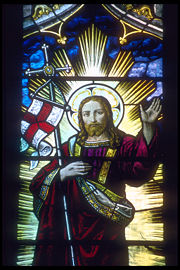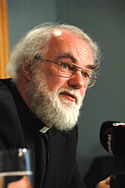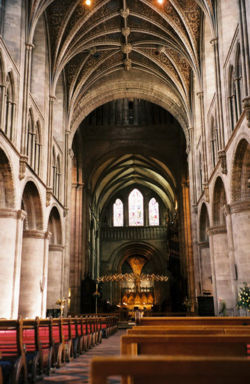Church of England
2008/9 Schools Wikipedia Selection. Related subjects: Religious movements, traditions and organizations
| Church of England | |
 The Church of England logo since 1996. |
|
| Classification | Anglican (1534- ), Roman Catholic (597-1534) |
|---|---|
| Orientation | Mainline |
| Polity | Episcopal |
| Separations | Congregationalism, Methodist Episcopal Church, other Methodist denominations |
| Associations | Anglican Communion, Porvoo Communion |
| Geographical Area | England, Isle of Man, Channel Islands |
| Statistics | |
| Members | 26 million |
| Ministers | 20,259 |
The Church of England is the officially established Christian church in England, the Mother Church of the worldwide Anglican Communion and the oldest among the communion's thirty-eight independent national churches.
The Church of England considers itself to be both Catholic and reformed:
- Reformed insofar as many of the principles of the early Protestant reformers as well as the subsequent Protestant Reformation have influenced it via the English Reformation and also insofar as it does not accept Papal supremacy or the Counter-Reformation.
- Catholic in that it views itself as being an unbroken continuation of both the early apostolic and later mediæval universal church, rather than as a new formation, and in that it holds and teaches the historic Catholic faith. In its customs and liturgy it has retained more of the Catholic tradition than most other churches touched by the Protestant Reformation.
History
The Church of England traces its formal corporate history from the 597 Augustinian mission, stresses its continuity and identity with the primitive universal Western church, and notes the consolidation of its particular independent and national character in the post- Reformation events of Tudor England.
According to tradition, Christianity arrived in Britain in the first or second century (probably via the tin trade route through Ireland and Iberia), and existed independently of the Church of Rome, as did many other Christian communities of that era. Records note British bishops, such as Restitutus in attendance at the Council of Arles in 314, and, even more significantly, Britain was the home of Pelagius, who nearly defeated Augustine of Hippo's doctrine of original sin.
The Pope sent Saint Augustine from Rome to evangelise the Angles in 597. With the help of Christians already residing in Kent he established his church in Canterbury, the former capital of Kent (it is now Maidstone), and became the first in the series of Archbishops of Canterbury. Later archbishop, the Greek Theodore of Tarsus, also contributed to the organisation of English Christianity.
Simultaneously, the Celtic Church of St Columba continued to evangelise Scotland. The Celtic Church of North Britain submitted in some sense to the 'authority' of Rome at the Synod of Whitby in 664. Over the next few centuries, the Roman system introduced by Augustine gradually absorbed the pre-existing Celtic Christian churches.
The English Church was under papal authority for nearly a thousand years, before separating from Rome in 1534 during the reign of King Henry VIII. A theological separation had been foreshadowed by various movements within the English Church such as the Lollards, but the English Reformation gained political support when Henry VIII wanted an annulment of his marriage to Catherine of Aragon, so he could marry Anne Boleyn. Under pressure from Catherine's nephew, the Emperor Charles V, Holy Roman Emperor, Pope Clement VII refused the annulment, and, eventually, Henry, although theologically a doctrinal Catholic, took the position of Supreme Head of the Church of England to ensure the annulment of his marriage. He was excommunicated by Pope Paul III.
Henry maintained a strong preference for the traditional Catholic practices and, during his reign, Protestant reformers were unable to make many changes to the practices of the Church of England. Indeed, this part of Henry's reign saw the trial for heresy of Protestants as well as Roman Catholics.
Under his son, Edward VI, however, the Church became theologically more radical, before legislatively rejoining the Roman church during the reign of Queen Mary I, in 1555. The settlement under Elizabeth I (from 1558) of a mildly reformed, Catholic, apostolic, and established church (i.e., subject to and part of the state) led to great civil strife in the following century.
For the next century, through the reigns of James I and Charles I, and culminating in the English Civil War and the protectorate of Oliver Cromwell, there were significant swings back and forth between two factions: the Puritans (and other radicals) who sought more far-reaching Protestant reforms, and the more conservative churchmen who aimed to keep closer to traditional beliefs and Catholic practices. The failure of political and ecclesiastical authorities to submit to Puritan demands for more extensive reform was one of the causes of open warfare. By Continental standards, the level of violence over religion was not high, but the casualties included a king, Charles I, and an Archbishop of Canterbury, William Laud. Under the Commonwealth and then the Protectorate of England from 1649 to 1660, Anglicanism was disestablished and outlawed, and in its place, presbyterian ecclesiology was introduced in place of the episcopate. In addition, the Articles were replaced with the Westminster Confession, and the Book of Common Prayer was replaced by the Directory of Public Worship. Despite this, about one quarter of English clergy refused to conform to this form of State Presbyterianism.
With the Restoration of Charles II, Anglicanism too was restored in a form not far removed from the Elizabethan version. One difference was that the ideal of encompassing all the people of England in one religious organisation, taken for granted by the Tudors, had to be abandoned. The religious landscape of England assumed its present form, with the Anglican Established church occupying the middle ground, and Roman Catholics and those Puritans who dissented from the Anglican Establishment, too strong to be suppressed altogether, having to continue their existence outside the National Church rather than controlling it.
Continuing official suspicion and legal restrictions continued well into the nineteenth century.
Membership
In addition to England proper, the jurisdiction of the Church of England extends to the Isle of Man, the Channel Islands, and a few parishes in Flintshire, Monmouthshire, and in Radnorshire, Wales. Expatriate congregations on the continent of Europe have become the Diocese of Gibraltar in Europe.
According to statistics "1.7 million people attend Church of England church and cathedral worship each month while around 1.2 million attend each week – on Sunday or during the week - and just over one million each Sunday."
Structure
The British monarch, at present Queen Elizabeth II, has the constitutional title of " Supreme Governor of the Church of England". The Canons of the Church of England state, "We acknowledge that the Queen’s most excellent Majesty, acting according to the laws of the realm, is the highest power under God in this kingdom, and has supreme authority over all persons in all causes, as well ecclesiastical as civil." The Church is then structured as follows:
- Primacy, e.g., Church of England. This is the area under the jurisdiction of a primate, e.g., the Archbishop of Canterbury. A primacy may consist of one or several provinces.
- Province, e.g., York and Canterbury (these are the only two in the Church of England). This is the area under the jurisdiction of an archbishop, i.e. the Archbishops of Canterbury and York. Decision making within the province is the responsibility of the General Synod (see also above). A province is subdivided into many dioceses.
- Diocese, e.g., Diocese of Durham, Diocese of Guildford, Diocese of St Albans, more. This is the area under the jurisdiction of a diocesan bishop, e.g., the Bishops of Durham, Guildford and St Albans, and will have a cathedral. There may also be one or more assisting bishops, usually called Suffragan Bishops, within the diocese who assist the diocesan bishop in his ministry, e.g., in Guildford Diocese, the Bishop of Dorking. In some very large dioceses a legal measure has been enacted to create "Episcopal Areas", in which case the diocesan bishop will run one such Area himself, and will appoint an "Area Bishop" to run each of the other Areas as mini-dioceses; in such cases, the diocesan bishop legally delegates many of his powers to the area bishops. Dioceses with Episcopal Areas include London, Southwark, Chichester, and Lichfield. The bishops will work with an elected body of lay and ordained representatives, known as the Diocesan Synod, to run the diocese. A diocese is subdivided into a small number of archdeanconry.
- Archdeaconry, e.g., Dorking. This is the area under the jurisdiction of an archdeacon. It will consist of a number of deaneries.
- Deanery, i.e., Lewisham, Runnymede. This is the area for which a rural dean is responsible. It will consist of a number of parishes in a particular region. The rural dean will usually be the incumbent of one of the constituent parishes. The parishes each elect lay (that is non-ordained) representatives to the Deanery Synod. Deanery Synod members each have a vote in the election of representatives to the Diocesan Synod.
- Parish, this is the most local level, often consisting of one church building and community, although nowadays many parishes are joining forces in a variety of ways for financial reasons. The parish will be looked after by a parish priest who for various historical or legal reasons may bear any of the following titles: Vicar, Rector, Priest-in-Charge, Team Rector or Team Vicar. The first, second, and fourth of these may also be known as the Incumbent. The running of the parish is the joint responsibility of the incumbent and the Parochial Church Council (PCC), which consists of the parish clergy and elected representatives from the congregation.
All rectors and vicars are appointed by patrons, who may be private individuals, corporate bodies such as cathedrals, colleges or trusts, or by the bishop or even appointed directly by the crown. No clergy can be instituted and inducted into a parish without swearing the Oath of Allegiance to Her Majesty, and taking the Oath of Canonical Obedience "in all things lawful and honest" to the bishop. Usually the archdeacon inducts into the actual possession of the benefice property - church and parsonage. Curates are appointed by rectors and vicars, but if priests-in-charge then by the bishop after consultations with the patron. Cathedral clergy are appointed either by the Crown, the bishop, or by the dean and chapter themselves. Clergy officiate in a diocese either because they hold office as beneficed clergy, or are licensed by the bishop when appointed (e.g. curates), or simply with permission.
Primates
The most senior bishop of the Church of England is the Archbishop of Canterbury, who is the archbishop and primate of the southern province of England, the Province of Canterbury. He also has the status of Primate of All England and Metropolitan. He is also the focus of unity for the worldwide Anglican Communion of independent national or regional churches. The Most Reverend and Right Honourable Rowan Williams has served as Archbishop of Canterbury since 2002.
The second most senior bishop is the Archbishop of York, who is the archbishop and primate of the northern province of England, the Province of York. For historical reasons he is referred to as the Primate of England. The Most Reverend and Right Honourable John Sentamu has served as the Archbishop of York since 2005.
Diocesan bishops
The process of appointing diocesan bishops is complex, and is handled by a body called the Crown Nominations Committee, which submits names to the Prime Minister (acting on behalf of the Crown) for consideration.
Representative bodies
The Church of England has a legislative body, the General Synod. Synod can create two types of legislation, Measures and Canons. Measures have to be approved but cannot be amended by the UK Parliament before receiving the Royal Assent and becoming part of the law of England. Canons require Royal Licence and Royal Assent, but form the law of the Church, rather than the law of the land.
There are also Diocesan Synods and Deanery Synods.
Worship and liturgy
The Book of Common Prayer
In addition to the Book of Common Prayer the church's other official liturgical book is Common Worship, dating from 2000. Like its predecessor, the 1980 Alternative Service Book, it differs substantially from the Book of Common Prayer, although it does include the Order Two rite of the Eucharist. This is a very slight revision of the prayer book service, altering only a few words and allowing the insertion of the Agnus Dei ( Lamb of God) before communion. The Order One rite follows the pattern of modern liturgical scholarship.
Doctrine and practice
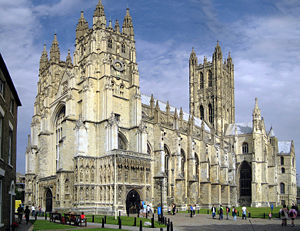
In both beliefs and practices, or forms of churchmanship, the Church of England is mixed: in some of its congregations worship remains closer to Roman Catholicism (see high church) than most Protestant churches, but in others it is difficult to distinguish between the Anglican forms in use and the uses of other Evangelical bodies (see low church). Its constitution affirms many relatively conservative theological beliefs, its liturgical form of worship is traditional, and its organisation embodies a belief in the appropriateness of the historical episcopal hierarchy of archbishops, bishops, and dioceses.
In many people's eyes, the Church of England has as its primary distinguishing heritage its breadth and "open-mindedness". Today, beliefs and practices range from those of the Anglo-Catholics, who emphasise liturgy and sacraments, to the far more preaching-centred and less ritual-based services of Evangelicals and gatherings of the Charismatics. But this " broad church" faces various contentious doctrinal questions raised by the development of modern society, such as conflicts over the ordination of women as priests (accepted in 1992 and begun in 1994), and the status of non-celibate homosexual clergy (still unsettled today). In July 2005 the divisions were once again apparent, as the General Synod voted to "set in train" the process of allowing the consecration of women as bishops; in February 2006 the synod voted overwhelmingly for "further exploration" of a scheme that would also allow parishes that did not want a woman bishop to opt for a man instead. On July 7, 2008 the church's governing body voted to confirm the ordination of women as bishops.
The church also has its own system of canon law, and judicial branch, known as the Ecclesiastical courts, which likewise form a part of the UK court system. Such courts have powers especially in relation to the care of churches and churchyards and the discipline of the clergy.
Ecumenical relations
Like many other Anglican churches, the Church of England has entered into full communion with the Old Catholics. In the late 20th century it also became a founding member of the new Porvoo Communion. The Church of England is also a full member of the Conference of European Churches.
Related churches
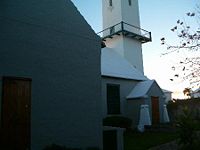
The Church of England's sister church in Ireland, the Church of Ireland, also went through the reformation in the sixteenth century. Unlike in England, the majority of the populace did not go along with this, preferring continued adherence to the Roman Catholic Church, but the Church of Ireland retained official established church status in Ireland until 1871. Under the Act of Union (Ireland) 1800, the Church of Ireland was united with the Church of England. This union was dissolved and the Irish church disestablished in 1871. To this day the Church of Ireland remains organised on an all-Ireland basis.
The Scottish Episcopal Church is the sister church in Scotland and is in full communion with it. It is much smaller than the Church of Scotland, which is recognised in law as the " national church" and has a Presbyterian system of government. The history of the Episcopal Church is complicated, involving alternating periods of official promotion and persecution: for a time, because of its association with Jacobitism, it had to operate sub rosa.
When the Episcopal Church in the U.S. became independent of the Church of England after the American War of Independence, the leadership of the Church of England did not believe itself legally able to consecrate new bishops without requiring of them the standard oath of loyalty to the crown. Consequently it was the non-juring bishops of the non-established Scottish Episcopal Church who consecrated the first American bishop, until new legislation allowed the Church of England to relax its policy.
The Church in Wales, previously a part of the Church of England, was disestablished in 1920 and at the same time became an independent member of the Anglican Communion.
Financial situation
The Church of England, although an established church, does not receive any direct government support. Donations comprise its largest source of income, though it also relies heavily on the income from its various historic endowments. As of 2005, the Church of England had estimated total outgoings of around £900 million.
Historically, individual parishes both raised and spent the vast majority of the Church's funding, meaning that clergy pay depended on the wealth of the parish, and parish advowsons (the right to appoint clergy to particular parishes) could become extremely valuable gifts. Individual dioceses also held considerable assets: the Diocese of Durham possessed such vast wealth and temporal power that its Bishop became known as the ' Prince-Bishop'. Since the mid-19th century, however, the Church has made various moves to 'equalise' the situation, and clergy within each diocese now receive standard stipends paid from diocesan funds. Meanwhile, the Church moved the majority of its income-generating assets (which in the past included a great deal of land, but today mostly take the form of financial stocks and bonds) out of the hands of individual clergy and bishops to the care of a body called the Church Commissioners, which uses these funds to pay a range of non-parish expenses, including clergy pensions, and the expenses of cathedrals and bishops' houses. These funds amount to around £3.9 billion, and generate income of around £164 million each year (as of 2003), around a fifth of the Church's overall income.
The Church Commissioners give some of this money as 'grants' to local parishes; but the majority of the financial burden of church upkeep and the work of local parishes still rests with individual parish and diocese, which meet their requirements from donations. Direct donations to the church (not including legacies) come to around £460 million per year, while parish and diocese reserve funds generate another £100 million. Funds raised in individual parishes account for almost all of this money, and the majority of it remains in the parish which raises it, meaning that the resources available to parishes still vary enormously, according to the level of donations they can raise.
Most parishes give a portion of their money, however, to the diocese as a 'quota'. While this is not a compulsory payment, dioceses strongly encourage and rely on it being paid; it is usually only withheld by parishes either if they are unable to find the funds or as a specific act of protest. As well as paying central diocesan expenses such as the running of diocesan offices, these diocesan funds also provide clergy pay and housing expenses (which total around £260 million per year across all dioceses), meaning that clergy living conditions no longer depend on parish-specific fundraising.

Although asset-rich, the Church of England has to look after and maintain its thousands of churches nationwide — the lion's share of England's built heritage. As current congregation numbers stand at relatively low levels and as maintenance bills increase as the buildings grow older, many of these churches cannot maintain economic self-sufficiency; but their historical and architectural importance make it difficult to sell them. In recent years, cathedrals and other famous churches have met some of their maintenance costs with grants from organisations such as English Heritage; but the church congregation and local fundraisers must foot the bill entirely in the case of most small parish churches. (The government, however, does provide some assistance in the form of tax breaks, for example a 100% VAT refund for renovations to religious buildings.)
In addition to consecrated buildings, the Church also controls numerous ancillary buildings attached to or associated with churches, including a good deal of clergy housing. As well as vicarages and rectories, this housing includes residences (called 'palaces') for each of the Church's 114 bishops. In some cases, this name seems entirely apt; buildings such as Archbishop of Canterbury's Lambeth Palace in London and Old Palace at Canterbury have truly palatial dimensions, while the Bishop of Durham's Auckland Castle has 50 rooms, a banqueting hall and 30 acres (120,000 m²) of parkland. However, many bishops have found the older palaces inappropriate for today's lifestyles, and some bishops' 'palaces' are ordinary four bedroomed houses. Many dioceses which have retained large palaces now employ part of the space as administrative offices, while the bishops and their families live in a small apartment within the palace; and in recent years some dioceses have managed to put their palaces' excess space and grandeur to profitable use as conference centres. All three of the more grand bishop's palaces mentioned above — Lambeth Palace, Canterbury Old Palace and Auckland Castle — serve as offices for church administration, conference venues, and only in a lesser degree the personal residence of a bishop. The size of the bishops' households has shrunk dramatically and their budgets for entertaining and staff form a tiny fraction of their pre-twentieth-century levels.
